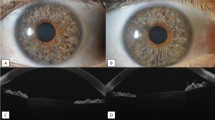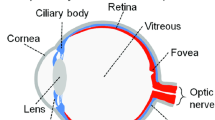Abstract
Background
Subretinal implants aim to replace photoreceptor function in patients suffering from degenerative retinal disease like retinitis pigmentosa by topically applying electrical stimuli in the subretinal space. This study—as a last step before upcoming human trials—explored a newly developed surgical technique for permanent implantation of complex subretinal implants with extra-ocular parts.
Methods
The implant consisted of a microphotodiode array (MPDA) with 1,550 electrodes and a 4×4 array of gold electrodes for direct electrical stimulation; both were mounted onto a polyimide foil for transscleral placement into the subretinal space. The foil carried connection lanes to a silicone cable that was implanted under the skin and led to a stimulator box in the animal’s neck. Surgery was performed in 11 domestic pigs. Improved vitreo-retinal surgical technique consisted of a 180° peripheral retinotomy and use of diathermy to penetrate the choroid in order to avoid choroidal haemorrhage. Subretinal forceps were used to place the implant safely onto the retinal pigment epithelium before the retina was flattened, peripheral laser photocoagulation was applied and the eye was filled with silicon oil. The implant was stabilized by a scleral fixation patch, use of a metal clamp with bone screws on the animal’s skull and a tissue ring under the animal’s skin in the neck. Behaviour was observed in the freely moving animals after direct subretinal electrical stimulation and funduscopy, optical coherence tomography, fluorescein angiography and histology were performed.
Results
All implants were successfully placed subretinally. In three animals a proliferative vitreo-retinopathy was observed after approximately 2 weeks. Otherwise, funduscopy and OCT demonstrated complete retinal attachment and FA showed no retinal vascular abnormalities over and around the implant. The animals showed clear behavioural reactions to electrical stimulation over the whole examination period. Histological examination failed to show any voltage-induced alteration in the cellular architecture of the retina overlying the stimulation electrodes.
Conclusions
This study demonstrates the feasibility of a new surgical procedure for highly safe and controlled implantation of complex subretinal devices with extra-ocular parts. The new implant design proved to be safely implantable in free-moving pigs for an observation period of 4 weeks.





Similar content being viewed by others
References
Abdel-Meguid A, Lappas A, Hartmann K, Auer F, Schrage N, Thumann G, Kirchhof B (2003) One year follow up of macular translocation with 360 degree retinotomy in patients with age related macular degeneration. Br J Ophthalmol 5:615–621
Acland GM, Aguirre GD, Ray J, Zhang Q, Aleman TS, Cideciyan AV, Pearce-Kelling SE, Anand V, Zeng Y, Maguire AM, Jacobson SG, Hauswirth WW, Bennett J (2001) Gene therapy restores vision in a canine model of childhood blindness. Nat Genet 1:92–95
Aisenbrey S, Lafaut BA, Szurman P, Grisanti S, Luke C, Krott R, Thumann G, Fricke J, Neugebauer A, Hilgers RD, Esser P, Walter P, Bartz-Schmidt KU (2002) Macular translocation with 360 degrees retinotomy for exudative age-related macular degeneration. Arch Ophthalmol 4:451–459
Akabane N, Yamamoto S, Tsukahara I, Ishida M, Mitamura Y, Yamamoto T, Takeuchi S (2001) Surgical outcomes in juvenile retinal detachment. Jpn J Ophthalmol 4:409–411
Al Torbak AA, Al Shahwan S, Al Jadaan I, Al Hommadi A, Edward DP (2005) Endophthalmitis associated with the Ahmed glaucoma valve implant. Br J Ophthalmol 4:454–458
Ali RR, Sarra GM, Stephens C, Alwis MD, Bainbridge JW, Munro PM, Fauser S, Reichel MB, Kinnon C, Hunt DM, Bhattacharya SS, Thrasher AJ (2000) Restoration of photoreceptor ultrastructure and function in retinal degeneration slow mice by gene therapy. Nat Genet 3:306–310
Chow AY, Chow VY, Packo KH, Pollack JS, Peyman GA, Schuchard R (2004) The artificial silicon retina microchip for the treatment of vision loss from retinitis pigmentosa. Arch Ophthalmol 4:460–469
Eckhorn R, Stett A, Schanze T, Gekeler F, Schwahn H, Zrenner E, Wilms M, Eger M, Hesse L (2001) Physiological functional evaluation of retinal implants in animal models. Ophthalmologe 4:369–375
Gekeler F, Kobuch K, Schwahn HN, Stett A, Shinoda K, Zrenner E (2004) Subretinal electrical stimulation of the rabbit retina with acutely implanted electrode arrays. Graefes Arch Clin Exp Ophthalmol 7:587–596
Hill DW, Young S (1975) Infrared angiography of the cat fundus oculi. Arch Ophthalmol 2:131–133
Horle S, Schmidt J, Kroll P (2000) Vitreoretinal surgery in complicated retinal detachment in children and adolescents. Ophthalmologe 7:482–486
Humayun MS, Weiland JD, Fujii GY, Greenberg R, Williamson R, Little J, Mech B, Cimmarusti V, Van Boemel G, Dagnelie G, de Juan E (2003) Visual perception in a blind subject with a chronic microelectronic retinal prosthesis. Vision Res 24:2573–2581
Kohler K, Hartmann JA, Werts D, Zrenner E (2001) Histological studies of retinal degeneration and biocompatibility of subretinal implants. Ophthalmologe 4:364–368
Kohler K, Sachs H, Zrenner E, Richter H (2003) Tissue reaction and biocompatibility following long-term implantation of electrical device into the subretinal space of cats and pigs. Invest Ophthalmol Vis Sci Abstract Annual Meeting
Kohler KL, Schmid H, Herrmann T, Stein B, Sailer H, Guenther E, Stett A (2005) Implanting electrical devices into the eye: evaluation of long-term tolerance and pathological thresholds of electrical stimuli to the retina. Invest Ophthalmol Vis Sci Abstract Annual Meeting
Moran WJ, Toljanic JA, Panje WR (1996) Implant-retained prosthetic rehabilitation of orbital defects. Arch Otolaryngol Head Neck Surg 1:46–50
Pertile G, Claes C (2002) Macular translocation with 360 degree retinotomy for management of age-related macular degeneration with subfoveal choroidal neovascularization. Am J Ophthalmol 4:560–565
Peterman MC, Noolandi J, Blumenkranz MS, Fishman HA (2004) Localized chemical release from an artificial synapse chip. Proc Natl Acad Sci USA 27:9951–9954
Qiu G, Seiler MJ, Mui C, Arai S, Aramant RB, de Juan E Jr, Sadda S (2005) Photoreceptor differentiation and integration of retinal progenitor cells transplanted into transgenic rats. Exp Eye Res 4:515–525
Radtke ND, Aramant RB, Seiler MJ, Petry HM, Pidwell D (2004) Vision change after sheet transplant of fetal retina with retinal pigment epithelium to a patient with retinitis pigmentosa. Arch Ophthalmol 8:1159–1165
Sachs H, Schanze T, Framme C, Gekeler F, Wilms M, Brunner U, Nisch W, Sailer H, Zrenner E, Gabel V-P (2005) The evaluation of subretinal stimulation by film-electrode arrays suitable for chronic human experiments in animal models. Invest Ophthalmol Vis Sci Abstract Annual Meeting
Sachs HG, Gabel VP (2004) Retinal replacement-the development of microelectronic retinal prostheses-experience with subretinal implants and new aspects. Graefes Arch Clin Exp Ophthalmol 8:717–723
Sachs HG, Gekeler F, Schwahn H, Jakob W, Kohler M, Schulmeyer F, Marienhagen J, Brunner U, Framme C (2005) Implantation of stimulation electrodes in the subretinal space to demonstrate cortical responses in Yucatan minipig in the course of visual prosthesis development. Eur J Ophthalmol 4:493–499
Sachs HG, Kobuch K, Köhler M, Schwahn HN, Gekeler F, Jakob W, Marienhagen J, Gabel V-P, Zrenner E (2000) Subretinal implantation of electrodes for acute stimulation of the retina to evoke cortical responses in minipig. Invest Ophthalmol Vis Sci Abstract Annual Meeting
Sachs HG, Schanze T, Brunner U, Sailer H, Wiesenack C (2005) Transscleral implantation and neurophysiological testing of subretinal polyimide film electrodes in the domestic pig in visual prosthesis development. J Neural Eng 1:S57–S64
Sachs HG, Schanze T, Wilms M, Rentzos A, Brunner U, Gekeler F, Hesse L (2005) Subretinal implantation and testing of polyimide film electrodes in cats. Graefes Arch Clin Exp Ophthalmol 5:464–468
Schanze T, Sachs HG, Wiesenack C, Brunner U, Sailer H (2005) Implantation and testing of subretinal film electrodes in domestic pigs. Exp Eye Res 82(2):332–340
Schraermeyer U, Thumann G, Luther T, Kociok N, Armhold S, Kruttwig K, Andressen C, Addicks K, Bartz-Schmidt KU (2001) Subretinally transplanted embryonic stem cells rescue photoreceptor cells from degeneration in the RCS rats. Cell Transplant 8:673–680
Schwahn HN, Gekeler F, Kohler K, Kobuch K, Sachs HG, Schulmeyer F, Jakob W, Gabel VP, Zrenner E (2001) Studies on the feasibility of a subretinal visual prosthesis: data from Yucatan micropig and rabbit. Graefes Arch Clin Exp Ophthalmol 12:961–967
Shinoda K, Kobuch K, Gekeler F, Blatsios G, Sailer H, Kohler K, Eckert E, Gabel V-P (2004) Transchoroidal implantation of subretinal devices in rabbit: overview of experimental experiences. Invest Ophthalmol Vis Sci Abstract Annual Meeting
Stett A, Barth W, Haemmerle H, Zrenner E (1998) Network activity of the chicken retina electrically evoked by distally applied spatial voltage patterns. Proceedings of the Goettingen Neurobiology Conference
Stett A, Barth W, Weiss S, Haemmerle H, Zrenner E (2000) Electrical multisite stimulation of the isolated chicken retina. Vision Res 40:1785–1795
Stett A, Kohler K, Weiss S, Haemmerle H, Zrenner E (1998) Electrical stimulation of degenerated retina of RCS rats by distally applied spatial voltage patterns. Invest Ophthalmol Vis Sci Abstract Annual Meeting
Stett A, Tepfenhart M, Kohler K, Nuesslin F, Haemmerle H, Zrenner E (1999) Charge sensitivity of electrically stimulated chicken and RCS rat retinae. Invest Ophthalmol Vis Sci Abstract Annual Meeting
Szurman P, Warga M, Roters S, Grisanti S, Heimann U, Aisenbrey S, Rohrbach JM, Sellhaus B, Ziemssen F, Bartz-Schmidt KU (2005) Experimental implantation and long-term testing of an intraocular vision aid in rabbits. Arch Ophthalmol 7:964–969
Volker M, Shinoda K, Sachs H, Gmeiner H, Schwarz T, Kohler K, Inhoffen W, Bartz-Schmidt KU, Zrenner E, Gekeler F (2004) In vivo assessment of subretinally implanted microphotodiode arrays in cats by optical coherence tomography and fluorescein angiography. Graefes Arch Clin Exp Ophthalmol 242(9):792–799
Acknowledgements
The study was supported in part by Retina Implant AG, Markwiesenstrasse 55, 72770 Reutlingen, Germany. We gratefully acknowledge the help of our project partners (Retina Implant AG: W. G. Wrobel, R. Rubow, H. Sailer, A. Harscher, S. Meine; Institute for Microelectronics, Stuttgart; Institute for Physical Electronics, Stuttgart: H.G. Graf, H. Gruber; all Germany). Helmut Sachs gave us friendly advice from his experience with subretinal implant surgery. Our veterinarians K. Pressler and S. Burgsmüller were outstanding in caring for our animals in the postoperative period. Gabi Fuchs and Annette Wagner were extremely helpful in surgery, as was A. Bezirgiannidis in providing help in installing the animal operation theatre. Without the excellent technical assistance and animal care provided by the team of the Hohenheim animal experimental unit (C. Fischinger, M. Mecchelem, W. Dunne, D. Günther, and J. Bzyl) this study would not have been possible. Regina Hofer contributed excellent graphics for Fig. 2. The German Ministry for Education and Research (BMBF) (grant no. 01KP0401) and the Ewald + Karin Hochbaum-Stiftung have once more generously supported our work.
Author information
Authors and Affiliations
Corresponding author
Rights and permissions
About this article
Cite this article
Gekeler, F., Szurman, P., Grisanti, S. et al. Compound subretinal prostheses with extra-ocular parts designed for human trials: successful long-term implantation in pigs. Graefe's Arch Clin Exp Ophthalmol 245, 230–241 (2007). https://doi.org/10.1007/s00417-006-0339-x
Received:
Revised:
Accepted:
Published:
Issue Date:
DOI: https://doi.org/10.1007/s00417-006-0339-x




